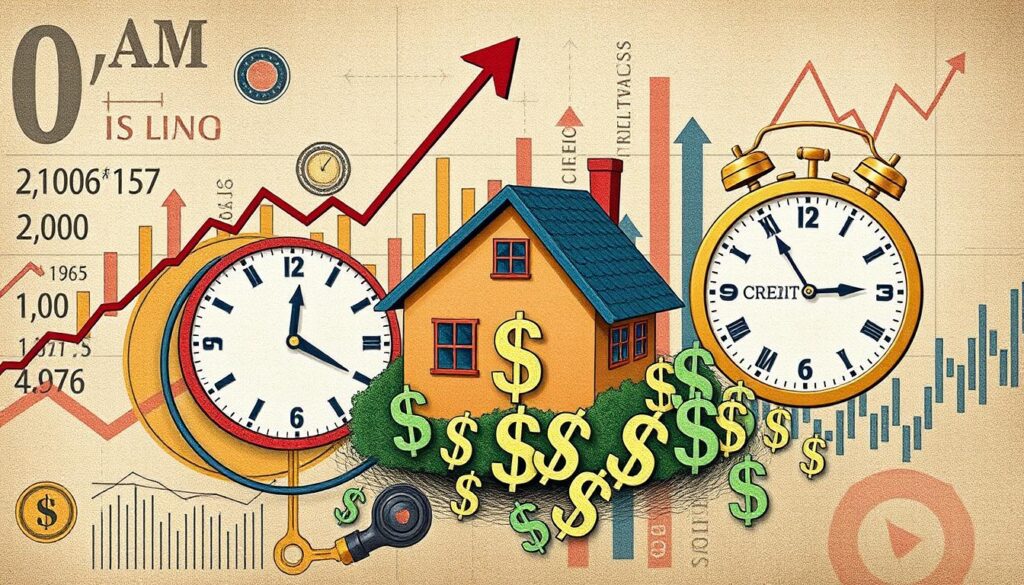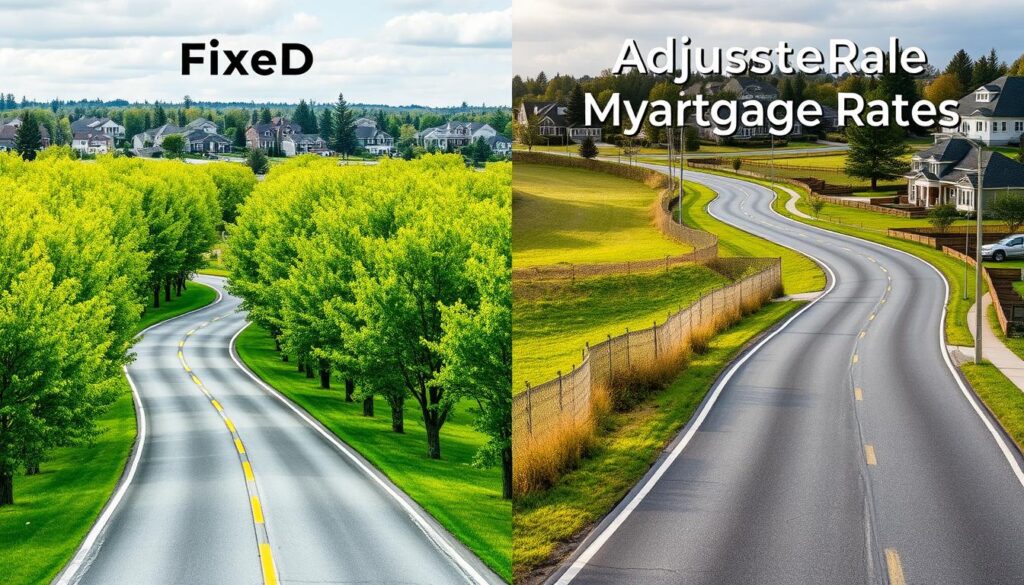Getting a handle on mortgage rates can seem overwhelming. But with our ultimate guide, you’ll learn how to make smart choices when you apply for a mortgage. We’ll break down mortgage rates in easy-to-understand terms, helping you through the mortgage world.
This guide will start with the basics of mortgage rates. You’ll learn how they’re set and what affects them. Knowing about mortgage rates will help you pick the best mortgage for you.

A visually engaging and informative illustration depicting the concept of mortgage rates, featuring a balance scale with varying percentages on one side and a house on the other, surrounded by dynamic arrows indicating fluctuations, graphs showing trends, and abstract representations of financial elements like coins and dollar signs, all set against a modern, stylized background that conveys finance and real estate.
The Ultimate Guide to Understanding Mortgage Rates
Knowing about mortgage rates is key when buying a home. Things like your credit score, how much you owe, and your income affect your mortgage rate. It’s important to understand these factors to make smart choices.
Economic factors like inflation and job rates also matter. Lenders look at these when setting mortgage rates. Keeping up with the economy helps you find the best mortgage rate.
What Determines Mortgage Rates
Many things decide your mortgage rate. Your credit score, how much you borrow, and the loan term are important. Lenders use this info to figure out the risk of lending to you. Knowing this helps you understand your mortgage better.
The Role of Economic Factors
Economic conditions greatly affect mortgage rates. A strong economy might mean higher rates, while a weak one could mean lower rates. Staying updated on the economy helps you make better mortgage choices.

“An intricate illustration depicting various factors influencing mortgage rates, featuring elements like a rising graph symbolizing economic trends, a house surrounded by dollar signs representing financial aspects, a clock indicating time sensitivity, and an abstract representation of credit scores, all set against a backdrop of fluctuating charts and numbers.”
How Lenders Calculate Your Rate
Lenders use indexes and margins to figure out your mortgage rate. The index is the base rate, and the margin is what’s added to it. Knowing this helps you find the best mortgage rate.
Important factors that affect mortgage rates include:
- Credit score
- Loan-to-value ratio
- Debt-to-income ratio
- Loan term
- Loan amount
By considering these factors and keeping up with the economy, you can understand mortgage rates better. This helps you make informed decisions about your mortgage.
Fixed vs. Adjustable Rate Mortgages: Making the Right Choice
Choosing a mortgage is a big decision. You must decide between a fixed or adjustable rate mortgage. Fixed rate mortgages keep the same interest rate and monthly payment for the loan’s term. In contrast, adjustable rate mortgages might start with lower rates but could increase, leading to higher payments.
Let’s look at the good and bad of each choice. Here are some important points to think about:
- Fixed rate mortgages protect you from rising interest rates
- Adjustable rate mortgages might start with lower rates but could increase
- Fixed rate mortgages are good for those who plan to stay in their home long-term
- Adjustable rate mortgages might be better for those who expect to move or refinance soon
The right choice between fixed and adjustable rates depends on your financial situation and goals. It’s crucial to weigh the pros and cons of each. By understanding the differences, you can make a smart choice and get the best mortgage for you.

A visual comparison of two distinct paths representing fixed and adjustable mortgage rates, one side featuring a steady, solid road with consistent green trees symbolizing stability, while the other side showcases a winding road with fluctuating hills and varied scenery illustrating change and adaptability, set against a backdrop of a suburban neighborhood with houses in the distance.
Key Factors That Influence Your Mortgage Rate
Several factors affect your mortgage rate. Knowing these can help you save money. Your credit score is a big one, as it can change your interest rate.
Credit Score Impact
A good credit score means lower interest rates. But, a bad score can lead to higher rates. Also, a bigger down payment can get you better rates.
Down Payment Considerations
Other things like your debt and the property type matter too. Keeping up with mortgage trends helps you find the best rate for you.
Debt-to-Income Ratio and Property Type
Important factors to think about include:
- Credit score and history
- Down payment amount
- Debt-to-income ratio
- Property type and location
Understanding these can help you save money on your loan. It’s all about making informed choices.
Understanding APR vs. Interest Rate: Beyond the Basics
When you’re looking at mortgages, you might see two terms that seem similar but aren’t exactly the same: APR and interest rate. The interest rate is the percentage of the loan you pay in interest each year. But the Annual Percentage Rate (APR) includes the interest rate, points, and fees. This gives you a clearer view of the mortgage’s total cost.
The APR is more than just the interest rate. It also includes fees like origination fees, discount points, and mortgage broker fees. These can greatly affect the mortgage’s cost. So, looking at the APR helps you make better choices when comparing different mortgage offers.
Here are some important things to remember when comparing APR and interest rate:
- Interest rate: The percentage of the loan amount that you’ll pay in interest over a year.
- APR: The total cost of the loan, including interest rate, points, and other fees.
- Fees: Various fees, such as origination fees, discount points, and mortgage broker fees, which can impact the overall cost of the mortgage.
Understanding the difference between APR and interest rate helps you feel more confident when choosing a mortgage. You can make choices that fit your financial goals better.
How to Shop for the Best Mortgage Rates
Finding the best mortgage rates is all about timing. Knowing how to compare rates can save you a lot of money. Start by looking at the current market and how it affects your loan.
To compare mortgage rates, you need to research different lenders. Look at online tools and bank websites to see what’s available. Remember, rates change every day, so keep up with the latest news.
Here are some tips for finding the best mortgage rates:
- Check your credit score and history to ensure you’re eligible for the best rates
- Research and compare rates from different lenders, including banks, credit unions, and online mortgage providers
- Consider working with a mortgage broker who can help you navigate the process and find the best deal
By following these tips and staying informed, you can find a great mortgage rate. Always read the fine print and ask questions before signing. With the right knowledge, you can get a great rate and start building your dream home.
| Lender | Interest Rate | Loan Term |
|---|---|---|
| Bank of America | 3.5% | 30 years |
| Wells Fargo | 3.75% | 30 years |
| Chase | 3.25% | 30 years |
Securing Your Financial Future: Smart Mortgage Rate Strategies
When you’re looking at mortgages, knowing about mortgage rate trends and finding the best mortgage rate is key. Understanding what affects mortgage rates helps you make smart choices. This way, you can reach your financial goals.
Whether you’re buying your first home or upgrading, mortgage rates matter a lot. They affect your monthly payments and your financial health. By keeping up with market news and comparing lender offers, you can save money and secure your future.
Your mortgage is a big deal, and doing your homework pays off. With smart planning and a careful approach, you can confidently find the right mortgage. This sets you up for a stable financial future.